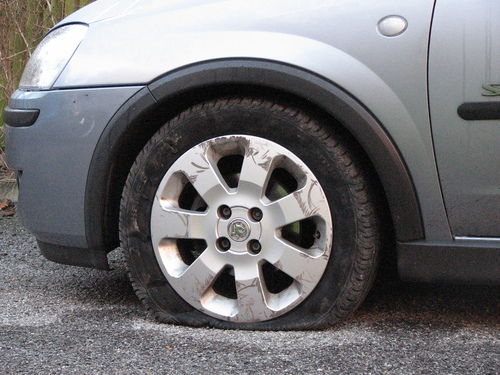About 75% of drivers have experienced a flat tire. How many of those people were able to change it themselves?
Changing a tire yourself can be an especially intimidating prospect, especially if you’ve never done it before. But here’s the good news: it’s not rocket science. Heck, it’s not even intermediate-level auto mechanics! Changing a flat tire and throwing on a spare is actually a lot simpler than you might imagine. It just takes a little bit of elbow grease to get you back on the road, feeling pretty clever.
How to Change a Flat Tire
-
Move Your Car to Somewhere Safe
Move your car to a flat surface if you’re not already on one, and pull away from the road as far as you can. Automatic transmissions should be in park, and manual transmissions should be in first gear. E-brake should be fully engaged. Don’t proceed to step 2 until you’ve put on your hazard lights.
-
Remove your Spare Tire and Jack from the Trunk.
-
Use The Flat End of Your Crowbar to Remove Your Hubcaps.
Use caution so you don’t damage them.
-
Check the Manual for Specific Instructions About the Jack.
It will tell you precisely where on your vehicle’s underside to position the jack so that when you begin lifting, you won’t damage or dent your molding.
-
Loosen the Lug Nuts
Crank the jack up until it’s snug, but don’t raise your car yet. Once you have the jack in position, use your crow bar/lug wrench to loosen the lug nuts of your tire by turning them counterclockwise. Don’t loosen them too far – only enough to get them turning. This can be the hardest part of changing your tire. If they’re not budging, you can get them turning by putting the wrench firmly in place and pressing down with all of your body weight.
-
Use the Jack to Lift the Car High Enough to Remove the Flat Tire.
-
Remove the Lug Nuts & Tire
Unscrew the lug nuts, set them aside where you won’t accidentally lose them. You can then take off the tire. You may get a bit of resistance, especially if it’s been a while since your tire was last removed for rotation. If you do, you can try to break the seal by rocking the tire left and right. Be sure that when you do this, you’re not causing the car or the jack to move.
-
Put the Spare On & Start to Screw in The Lug Nuts
Set your flat tire aside and mount the spare by lining up the holes with the stud and positioning it firmly in place. Screw the lug nuts back into place by hand, turning them clockwise until they fit snugly.
-
Partially Lower the Jack and Finish Screwing in the Lug Nuts
Don’t lower the jack fully; instead, lower it until there’s enough weight to let you safely tighten the lug nuts using your crow bar/lug wrench.
-
Lower the Jack Fully and Retighten the Nuts
Tighten the lug nuts again to ensure that, once you’re rolling again, they won’t come loose. Try not to over tighten them, as this can cause them to strip out later when you take your car to a mechanic to remove the spare and replace it with a new (or repaired) tire.
Once you’ve accomplished this, toss your flat tire and jack back into the trunk of your vehicle and get yourself to a mechanic. Depending on the cause of the flat, you may only need a simple patch job to get you rolling again. Easy enough, right?
Now that you know how to change a flat tire, consider a practice run in your driveway when you’ve got a bit of spare time. Learning how can save you a serious wad of cash you’d otherwise spend on a tow truck.
Good luck on the roads, and steer clear of potholes and debris to decrease your odds of getting a flat.

